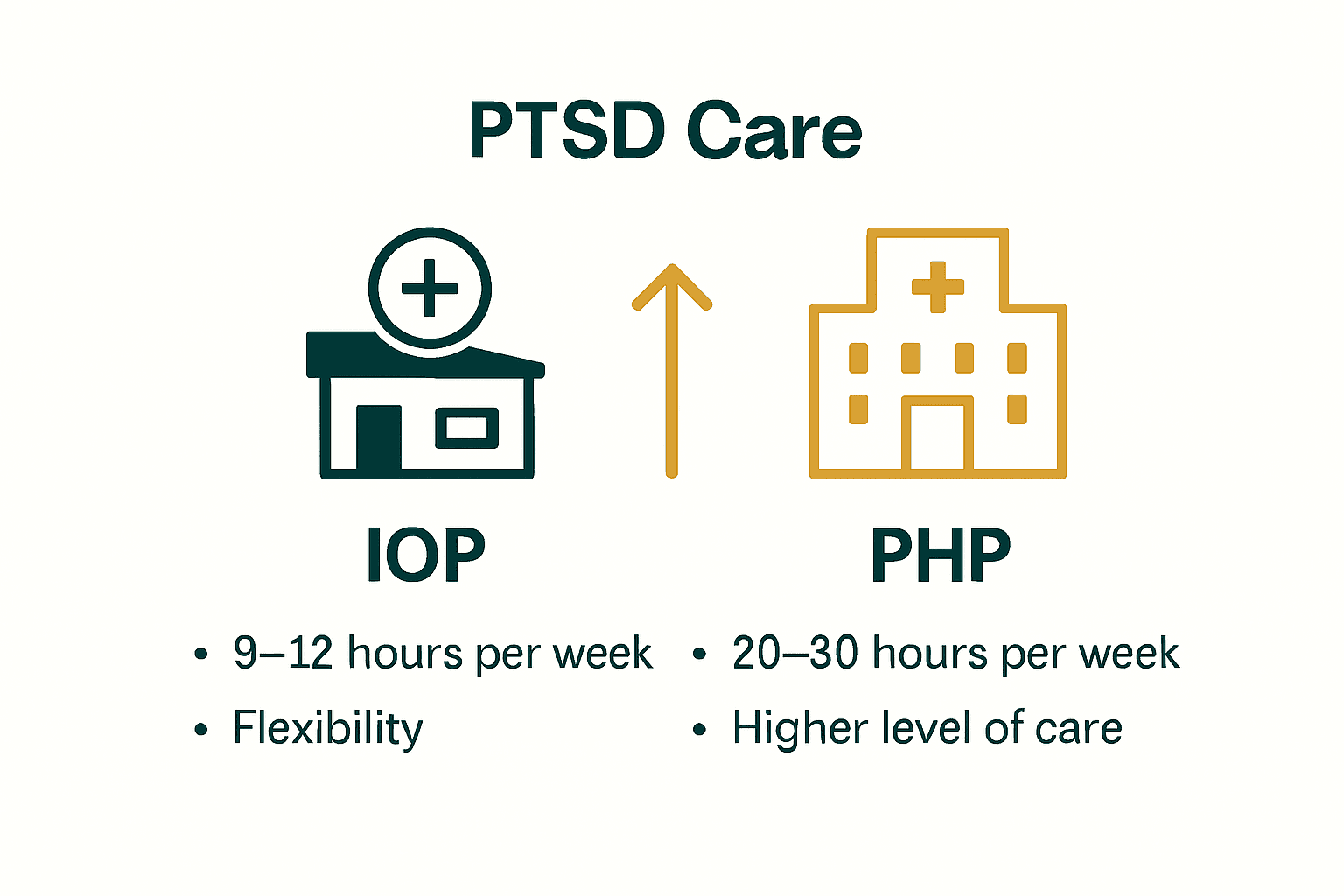Nearly one in ten Americans will experience PTSD during their lifetime, often facing symptoms that linger for years without help. Living with untreated PTSD can disrupt relationships, work, and daily well-being, leaving many feeling trapped by their trauma. Understanding how professional treatment can shorten recovery by almost half offers hope. Exploring proven therapies and program options can empower individuals and their loved ones to take charge of healing and reclaim a sense of safety and control.
Key Takeaways
| Point | Details |
|---|---|
| PTSD Nature | PTSD is a persistent mental health condition caused by trauma, affecting 6-9% of Americans and lasting an average of 64 months without treatment. |
| Integrated Treatment | Effective PTSD treatment combines psychotherapy and medication management, significantly reducing symptom duration. |
| Therapy Timelines | Common therapy methods have specific session ranges; Cognitive Behavioral Therapy typically takes 12-16 weeks while massed treatment can provide recovery in 10-12 days. |
| Recovery Factors | Recovery duration is influenced by treatment timing, social support, trauma severity, personal resilience, and comorbid conditions. |
Table of Contents
- Defining Ptsd And Treatment Fundamentals
- Common Ptsd Therapy Methods And Timelines
- Program Types: Iop, Php, And Their Lengths
- Factors Influencing Recovery Duration
- Expectations, Milestones, And Relapse Risks
Defining PTSD and Treatment Fundamentals
Post-Traumatic Stress Disorder (PTSD) is a complex mental health condition triggered by experiencing or witnessing severely traumatic events. Unlike typical stress responses that fade over time, PTSD symptoms persist, disrupting daily functioning and emotional well-being. According to research, approximately 6-9% of Americans will experience PTSD at some point in their lives, with symptoms potentially lasting an average of 64 months without proper treatment.
Treatment fundamentals for PTSD are comprehensive and multifaceted, designed to help individuals process traumatic memories and develop healthy coping mechanisms. Integrated treatment approaches at our mental health center typically combine two primary strategies:
- Psychotherapy: Evidence-based treatments like Cognitive Processing Therapy and Eye Movement Desensitization and Reprocessing (EMDR)
- Medication Management: Targeted psychiatric medications to manage anxiety, depression, and traumatic stress symptoms
Research indicates that combined treatment significantly improves outcomes. Without intervention, PTSD symptoms may persist for an average of 64 months, whereas structured treatment can reduce symptom duration to approximately 36 months. This underscores the critical importance of seeking professional help and committing to a personalized recovery plan that addresses individual trauma experiences and emotional needs.
Common PTSD Therapy Methods and Timelines
Therapeutic approaches for PTSD are diverse, with each method targeting trauma recovery through unique strategies. Cognitive Behavioral Therapy (CBT) remains one of the most prominent interventions, typically spanning 12 to 16 weeks and demonstrating exceptional effectiveness, particularly among veterans experiencing complex trauma responses.
Several evidence-based therapy methods have emerged as powerful tools in PTSD treatment:
- Cognitive Processing Therapy (CPT): Involves 10-12 sessions focusing on reframing traumatic memories and challenging distorted thought patterns
- Prolonged Exposure Therapy: Requires 8-15 sessions helping patients gradually confront trauma-related memories and situations
- EMDR Therapy: Utilizes 8-12 sessions using bilateral stimulation to process traumatic experiences
Interestingly, research suggests that massed treatment—where patients undergo daily therapy sessions—can accelerate recovery, potentially achieving significant healing within 10 to 12 days. This intensive approach offers hope for individuals seeking faster trauma resolution, though individual experiences may vary based on personal trauma complexity and individual resilience. The key is finding a personalized treatment plan that provides comprehensive support and recognizes the unique healing journey of each person confronting post-traumatic stress.
Here’s a comparison of common PTSD therapy approaches and their typical timelines:
| Therapy Method | Typical Sessions | Key Focus |
|---|---|---|
| Cognitive Processing Therapy | 10-12 | Reframe traumatic memories Challenge thoughts |
| Prolonged Exposure Therapy | 8-15 | Gradual trauma exposure Reduce avoidance |
| EMDR Therapy | 8-12 | Bilateral stimulation Process trauma |
| Cognitive Behavioral Therapy | 12-16 | Identify negative beliefs Build coping skills |
| Massed Treatment | 10-12 days | Daily sessions Accelerated recovery |
Program Types: IOP, PHP, and Their Lengths
Mental health treatment for PTSD isn’t one-size-fits-all. Two critical program types—Intensive Outpatient Programs (IOPs) and Partial Hospitalization Programs (PHPs)—offer flexible yet structured approaches to trauma recovery. Learn more about our intensive treatment options that can be tailored to individual healing needs.
Intensive Outpatient Programs (IOPs) provide a robust treatment framework while allowing patients to maintain their daily life commitments. According to research, these programs typically deliver 9 to 19 hours of structured therapy per week, including both group and individual sessions. Key features include:
- Flexible scheduling enabling work and family obligations
- 9-19 weekly treatment hours
- Continued home residence
- Comprehensive therapeutic support
Partial Hospitalization Programs (PHPs) represent a more immersive treatment approach. These programs provide a higher level of care where individuals participate in daily therapeutic activities while continuing to live at home. PHPs can involve treatment up to seven days a week, offering intensive support for individuals requiring more comprehensive intervention. The goal is to provide structured, consistent care that supports profound healing while maintaining patients’ connection to their home environment and support systems.
Factors Influencing Recovery Duration
Recovery from PTSD is a complex, deeply personal journey influenced by multiple interconnected factors. Psychological research suggests that trauma recovery isn’t linear, but depends on intricate pre-trauma, peri-trauma, and post-trauma experiences. Understanding these recovery dynamics can help individuals and their support networks navigate the healing process more effectively.
Several key factors significantly impact PTSD recovery duration and outcomes:
- Timing of Treatment: Early intervention dramatically improves recovery prospects
- Social Support: Strong, consistent emotional networks accelerate healing
- Trauma Severity: More intense or prolonged traumatic experiences may require extended treatment
- Personal Resilience: Pre-existing mental health and coping mechanisms play crucial roles
- Comorbid Conditions: Presence of additional mental health or substance use disorders can complicate recovery
Research indicates that individuals with favorable prognosis typically demonstrate consistent social support, prevent re-traumatization, maintain good premorbid functioning, and address any concurrent mental health challenges. The most successful recovery approaches recognize that healing is multidimensional—involving emotional, psychological, and social rehabilitation. Each person’s trauma journey is unique, requiring personalized, compassionate treatment strategies that respect individual experiences and provide comprehensive, adaptive support.
Expectations, Milestones, and Relapse Risks
PTSD recovery is a nuanced journey marked by non-linear progression, where breakthroughs and challenges coexist. Research emphasizes that healing isn’t a straightforward path, but a complex process of emotional and psychological transformation. Understanding potential recovery trajectories can help individuals set realistic expectations and maintain hope during challenging moments.
Key recovery milestones and potential challenges include:
- Initial Stabilization: Reducing acute trauma symptoms and establishing emotional safety
- Symptom Management: Developing coping strategies and emotional regulation techniques
- Cognitive Restructuring: Challenging and reframing trauma-related thought patterns
- Integration: Rebuilding personal narrative and reconnecting with life goals
- Maintenance: Sustaining progress and preventing potential relapse
Research reveals that only 20–30% of patients achieve full recovery with medication alone, and over one-third may never completely resolve their PTSD symptoms. This underscores the importance of comprehensive treatment approaches combining therapy, medication, and ongoing support. Relapse risks remain significant, highlighting the need for continuous engagement, adaptive treatment strategies, and a compassionate understanding that recovery is a deeply personal journey with unique challenges and triumphs for each individual.
Ready for Real Progress? Start Your Personalized PTSD Recovery Now
You learned in this guide that PTSD recovery is not just about waiting for symptoms to fade. Often the real challenge lies in finding a treatment that works and understanding why progress sometimes feels so slow. If you are struggling to move forward or feeling uncertain about the timeline, you are not alone. Complex trauma, the importance of individual support, and the need for flexible programs are just a few of the hurdles discussed in this article. Addressing these pain points calls for more than a one-size-fits-all approach, especially when therapy types and recovery milestones may differ from person to person.
At Glendora Recovery Center, we specialize in evidence-based programs for PTSD that match your unique recovery journey. Whether you need an intensive outpatient solution with flexible hours, or want comprehensive care through partial hospitalization, our experienced team offers compassionate support every step of the way. Why wait for months—or even years—for things to improve on their own? Make today your turning point. Connect with us now to discuss personalized treatment options that can help you achieve lasting progress and get your life back.
Frequently Asked Questions
How long does PTSD treatment typically last?
The duration of PTSD treatment varies by method, but common therapies like Cognitive Processing Therapy usually span 10-12 sessions, while Prolonged Exposure Therapy may require 8-15 sessions. Intensive Outpatient Programs (IOPs) typically involve 9-19 hours of therapy per week, while Partial Hospitalization Programs (PHPs) can provide support up to seven days a week.
What are the most effective therapy methods for PTSD?
Some of the most effective therapy methods for PTSD include Cognitive Processing Therapy (CPT), Prolonged Exposure Therapy, and Eye Movement Desensitization and Reprocessing (EMDR). Each method has its own focus and duration, tailored to individual trauma experiences.
What factors influence the recovery duration from PTSD?
Recovery duration from PTSD is influenced by several factors, including the timing of treatment, social support availability, trauma severity, personal resilience, and the presence of comorbid conditions. Early intervention and strong support networks greatly enhance recovery prospects.
Can PTSD symptoms resolve completely with treatment?
While treatment can greatly reduce PTSD symptoms, research indicates that only 20-30% of patients achieve full recovery with medication alone, and over one-third may never completely resolve their symptoms. Comprehensive treatment approaches that combine therapy and medication are essential for optimal outcomes.





